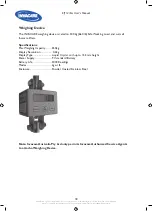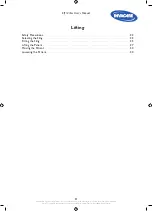
24
25
!
PRIOR TO USE: inspect slings including webbing, straps and buckles for wear.
Examine stitching for fraying, breakage and unravelling. DAMAGED SLINGS
SHOULD NOT BE USED. If in doubt, do not use.
(Refer ‘Sling Care’ for detailed maintenance recommendations on Page 32.)
Fitting the Sling
General Purpose and Pivot Slings
Fit the sling to the patient before wheeling the lifter into position to carry out the lift.
Patient in Chair
Hold up the sling so that the label sewn to the back of the sling is away from the patient.
Slide the body of the sling down the patient’s back until the base of the sling is level with the
base of the spine.
Pass the leg sections of the sling under each thigh. It is important that each leg section supports
as much of the patient’s thigh and hip as possible. This can be achieved by firmly pulling the leg
piece once it is passed under the leg.
To ease the leg strap under the patient’s hip, it sometimes helps to place one hand between the
patient’s leg and the sling as the strap is being tensioned.
Tip:
When preparing for a lift from a chair, wheel the lifter into position by approaching from the front or, in
the case of some wheelchairs or special chairs, from the side. Take care to ensure you do not push the lifting
yoke or pivoting frame into the patient’s head or face.
All information is subject to change without prior notice. Photographs are for illustration purposes only and may vary from product description.
Invacare
®
is a registered trademark and Yes, you can.™ is a trademark of Invacare
®
Corporation. 2008 Invacare Asia Pacific
Elf 127em User's Manual
Elf 127em User's Manual
All information is subject to change without prior notice. Photographs are for illustration purposes only and may vary from product description.
Invacare
®
is a registered trademark and Yes, you can.™ is a trademark of Invacare
®
Corporation. 2008 Invacare Asia Pacific
















































